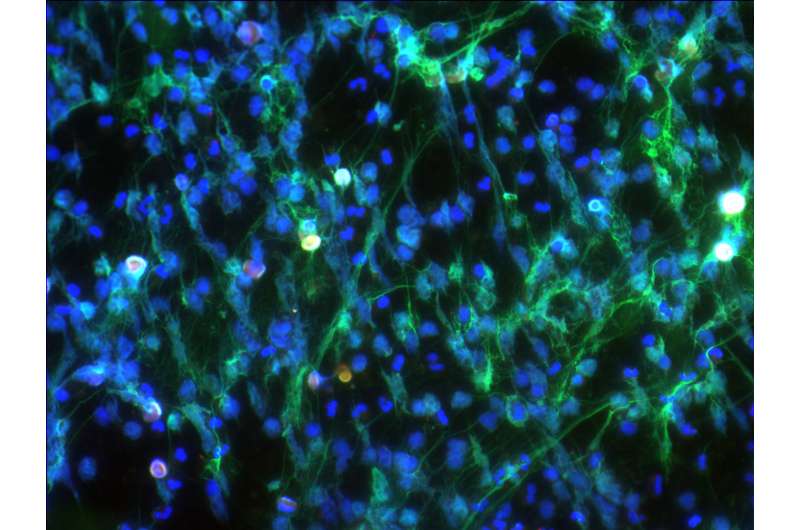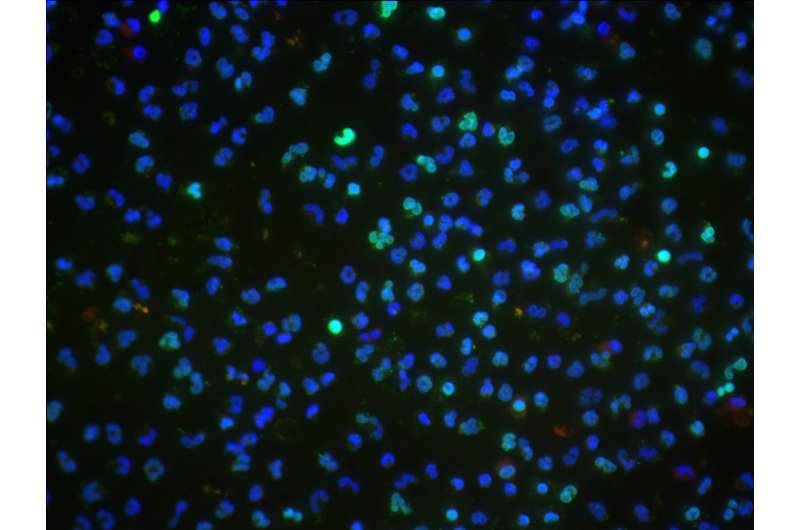Research team discovers a pathogen's motility triggers immune response

Until now, a pathogen's ability to move through the body has been overlooked as a possible trigger of immune response, but new research from the University of Georgia College of Veterinary Medicine found that motility will indeed alarm the host and activate an immune response.
The team, led by Balázs Rada, an assistant professor in the department of infectious diseases in the UGA College of Veterinary Medicine, studied Pseudomonas aeruginosa, an opportunistic bacterium that can wreak havoc on patients who have a weakened immune system—like burn patients or those battling HIV, cystic fibrosis, cancer or pneumonia.
Data from the study, published in mid-November in PLOS Pathogens, suggest that a bacteria's ability to swim, also known as motility, is an important factor to certain opportunistic pathogens, like P. aeruginosa. The team identified the flagellum—a whip-like appendage that works like a propeller to move the bacteria—as the main P. aeruginosa component that triggers the immune system to release what are called neutrophil extracellular traps, or NETs. NETs are web-like structures of DNA associated with antimicrobial molecules that trap and kill microbes.
The study is the first to show that flagellar motility induces activation of neutrophils, the most abundant type of white blood cell in most mammals and the first line of defense against infection.
This finding was a surprise to the Rada team.
"It's a step along the way to direct research attention toward bacterial motility," said Rada, the study's senior author. "It's an important feature of the bacterium that has been neglected in the past."
Through the data the team gathered, they were able to isolate the immune response trigger and pinpoint motility as the culprit by testing bacteria with immotile flagella. These immovable flagella failed to activate neutrophil response.

Forced contact between P. aeruginosa bacilli with paralyzed flagella and neutrophils, however, did trigger a maximal immune response.
Purified bacterial flagellin—the protein that makes up flagella—did not activate neutrophils to release NETs. This suggests that while the cell-to-cell contact is key to spark the body's immune response, the actual motorized bacterial movement catalyzes the chain of events that leads to binding and subsequent immune reaction.
Most people with cystic fibrosis are infected with P. aeruginosa, which can make their lung disease worse. However, P. aeruginosa is known to lose its motility early on in the lung of someone with cystic fibrosis. This study offers a potential new explanation for why this happens: The Rada team suggests that the bacterium suppresses flagellin synthesis over time to avoid recognition by neutrophils and triggering immune responses.
Understanding this mechanism in cystic fibrosis patients with P. aeruginosa infections can help scientists develop motility-targeting therapies, Rada said.
This study also highlights the importance of focusing on neutrophils as the bacteria-binding target.
"It's the most powerful branch of the immune system to fight P. aeruginosa, and our study shows how the bacteria and neutrophils interact," Rada said, adding that this previously uncharted territory suggests not only the importance of bacterial motility but also that neutrophils are a key cell type to study with regards to P. aeruginosa infections.
Clinical research is needed to track the bacteria's motility mechanism in cystic fibrosis and other immunocompromised patients, he said. This study is useful to understand the early pathogenicity of P. aeruginosa infections.
Though this study focuses specifically on P. aeruginosa's motility, the data also provide insight into the mechanism of neutrophil activation elicited by other flagellated bacteria.
The study, "Swimming Motility Mediates the Formation of Neutrophil Extracellular Traps Induced by Flagellated Pseudomonas aeruginosa," was published Nov. 17.
More information: Madison Floyd et al. Swimming Motility Mediates the Formation of Neutrophil Extracellular Traps Induced by Flagellated Pseudomonas aeruginosa, PLOS Pathogens (2016). DOI: 10.1371/journal.ppat.1005987
Journal information: PLoS Pathogens
Provided by University of Georgia




















